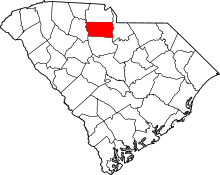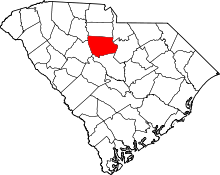Blackstock, South Carolina
| Blackstock, South Carolina | |
|---|---|
| Unincorporated community | |
 Blackstock  Blackstock | |
| Coordinates: 34°33′31″N 81°09′08″W / 34.55861°N 81.15222°WCoordinates: 34°33′31″N 81°09′08″W / 34.55861°N 81.15222°W | |
| Country | United States |
| State | South Carolina |
| Counties | Chester, Fairfield |
| Elevation | 620 ft (190 m) |
| Time zone | UTC-5 (Eastern (EST)) |
| • Summer (DST) | UTC-4 (EDT) |
| ZIP code | 29014 |
| Area code(s) | 803 |
| GNIS feature ID | 1246908[1] |
Blackstock is an unincorporated community in Chester and Fairfield counties in the Midlands of South Carolina about 45 miles (72 km) north of Columbia. The elevation of the community is 620 feet (190 m).[1] Its ZIP code is 29014.[2] The Cornwell Inn, located on Blackstock Road, was listed on the National Register of Historic Places in 1994.[3]
Government
Blackstock is an unincorporated community. Accordingly, it has no municipal government.
Certain portions of the community are located in Fairfield County, while others are located in Chester County. As a result, both counties exercise a measure of control over the affairs of the community and provide services to it.
History
Around 1880, a noticeable boom in the number of small towns situated along the railroads of the South occurred. South Carolina historian Walter Edgar describes the period between 1880 and 1920 as one when thriving general stores with smaller specialty stores around them operated along the railroads. Among the small stores were often cotton pressing and cottonseed oil operations.[4] The collection of stores and mills near the lines made the production of cotton more efficient and profitable in those small towns. A Fairfield Herald article from March 8, 1876 described Blackstock, South Carolina as one of the new cotton-producing towns along the railroad. Parallel to the track in Blackstock one could find the depot, post office, and “most of the business houses."[5] An article in The News and Herald of Rock Hill from August 1883 tells of a rapidly expanding Blackstock. So many new businesses and houses were being built near the rail line that well-diggers and construction companies could not keep pace.[6] The economy of Blackstock was also helped by the construction of new textile mills in the neighboring towns of Great Falls and Chester. In 1883 a new 10,000 spindle textile factory had just been completed in Great Falls.[7]
Blackstock endured some serious economic shocks between 1920 and 1940. At the turn of the century 144 trains a day came through Columbia, South Carolina’s capital located 50 miles south of Blackstock on the Southern Railroad route.[8] In 1920 the traffic was even greater as trade between the North and South increased rapidly. Many of the trains that traveled through Columbia stopped in Blackstock for 15 to 45 minutes.[9] The farming families of Blackstock similarly gravitated toward the railway depot. A.E. Perkins wrote in his 1938 work The South: Its Economic-Geographic Development that “Nearly every farm is within 10 to 20 miles, at the most, of a railroad and few are more than 25 miles from a railroad shipping point.”[10] Cotton traded to the Durham store was sold by rail to manufacturers down the line and a majority of the goods offered to Blackstock’s citizenry by Durham were shipped in by rail.
In the first 6 months of 1921 the market price of cotton was 41 cents per pound.[11] By December the price per pound had fallen to 13 ½ cents - a drop of over 66% in market price.[12] The farmers of the Blackstock community were suddenly in dire straights as the cost of production had not decreased along with the prices they received for their produce. The boll weevil pest was responsible for a great deal of the misery suffered by South Carolina cotton farmers after 1920. In 1922, South Carolina cotton farmers produced 22% fewer bales than they had in 1920.
Attractions
The South Carolina Office of Tourism encourages travelers to visit one monument in Blackstock.[13] This monument, dedicated to the slave Burrel Hemphill, can be found on the front grounds of Hopewell ARP Church. [14] The monument consists of a small stone building with a placard that reads as follows: "In memory of Burrel Hemphill, killed by Union solders February 1865. Although a slave, he gave his life rather than betray a trust. He was a member of Hopewell." [15] One account of Hemphill's death states that he was tortured and killed by U.S. soldiers after refusing to disclose where his master had hidden certain valuables. [16] The story of Burrel Hemphill's sacrifice has been the subject of historical programs led by Dr. W.T. Holmes, a descendant of Mr. Hemphill's, as recently as 2017. [17]
A gymnasium which was once part of Blackstock High School has hosted bluegrass concerts on a weekly basis since November 1998.[18] The venue hosts multiple stages where performers are permitted to play regardless of age or skill level.[18] Although attendance is not taken, it is estimated that between 150 and 200 people attend the concerts each week.[18]
Notable natives
Posthumous Pardon
On April 24, 1913, Confederate States of America veteran John Q. Lewis was murdered in Blackstock.[20] An investigation of the murder led to the arrest, prosecution, and conviction of Thomas and Meeks Griffin - two African-American residents of the town.[20] Doubts about the conviction inspired more than 150 residents of the town, including the mayor and a former sheriff of Chester County, to petition for governor of South Carolina to commute the sentences.[20] The list of petitioners included "many white leaders of the community and ordinary white citizens."[20] However, the men were executed on September 29, 1915.[20] Research demonstrating the inequity of the matter was presented to the parole board in 2009 and led the state to issue its first posthumous pardon in a capital murder case.[20]
References
- 1 2 "Blackstock, South Carolina". Geographic Names Information System. United States Geological Survey.
- ↑ United States Postal Service (2012). "USPS - Look Up a ZIP Code". Retrieved 2012-02-15.
- ↑ National Park Service (2010-07-09). "National Register Information System". National Register of Historic Places. National Park Service.
- ↑ Burke Davis. The Southern Railway. Chapel Hill, NC: University of North Carolina Press, 1985. p. 42
- ↑ H.A. Gaillard. The Fairfield Herald. 8 March 1876.
- ↑ “A Run To Blackstock.” The News and Herald. 7 August 1883.
- ↑ “A Run To Blackstock.” The News and Herald. 7 August 1883.
- ↑ Walter Edgar. South Carolina: A History. Columbia, SC: University of South Carolina Press, 1998. p454
- ↑ John I. Sanders, Mr. Will Durham and His Country Store (2007)
- ↑ A.E. Perkins. The South: It’s Economic-Geographic Development. New York: John Wiley and Sons Inc, 1938. p174
- ↑ Walter Edgar. South Carolina: A History. Columbia, SC: University of South Carolina Press, 1998. p481
- ↑ Walter Edgar. South Carolina: A History. Columbia, SC: University of South Carolina Press, 1998. p481
- ↑ South Carolina Office of Tourism, https://discoversouthcarolina.com/products/3504
- ↑ South Carolina Office of Tourism, https://discoversouthcarolina.com/products/3504
- ↑ South Carolina Office of Tourism, https://discoversouthcarolina.com/products/3504
- ↑ Charles Kelley Barrow and J.H. Segars, Black Southerners in Confederate Armies: A Collection of Historical Accounts, Pelican Publishing Company (2007)
- ↑ Staff Reports, Dr. W.T. Holmes to present history of Burrel Hemphill, The News and Reporter (July 6, 2017)
- 1 2 3 "Blackstock Bluegrass Association".
- ↑ "Ed Durham: Society for American Baseball Research".
- 1 2 3 4 5 6 Drash, Wayne (October 15, 2009). "Tom Joyner get justice for electrocuted kin, 94 years later". CNN.

